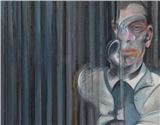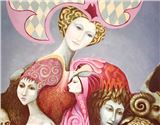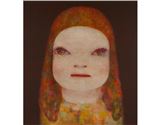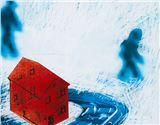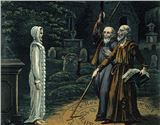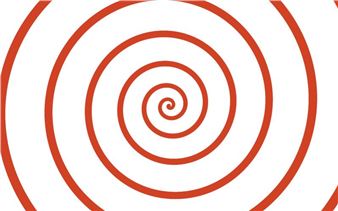The Art of Golf
The exhibition begins with a display devoted to the depiction of kolf, a cousin of the modern game, as depicted in early Dutch landscape and genre paintings of the 17th century. This section will include Rembrandt's famous etching The Ringball Player (1654) and winter landscapes by Hendrick and Barent Avercamp, which depict kolf being played on the frozen canals of Holland. Following in the display will be Scottish artworks of the 18th century, including the earliest known depiction of golf being played in Scotland (ca. 1740). Also included will be a series of iconic Scottish golfing portraits from the National Galleries of Scotland, including a stunning full-length portrait of the tartan-clad Sir James and Sir Alexander MacDonald (ca. 1749) by William Mosman and an incisive portrayal of William Inglis, Captain of the Honourable Company of Edinburgh Golfers (ca. 1790), by Sir Henry Raeburn, the preeminent portraitist of the Scottish Enlightenment. Among many objects that will be lent from the collection of the world-renowned Royal and Ancient Golf Club in St Andrews, Scotland, is the charming portrait of Old Tom Morris by Sir George Reid. Morris was one of the great early players, winning four British Opens in the 1860s and also earning fame as a clubmaker and course designer.
The centerpiece of the exhibition is known as greatest golfing painting in the world: Charles Lees’s The Golfers, which portrays in detail a match played on the Old Course at St Andrews in 1847. Jointly owned by the National Galleries of Scotland and the Royal and Ancient Golf Club, this masterpiece has never before traveled to the United States, though reproductions of it hang in golf clubhouses around the world. Displayed alongside the painting are several preparatory sketches, all portraits of individuals who can be identified in the painting, and an early photograph by Hill and Adamson to which Lees referred as he composed his painting. Also included in this section is golfiana (antique balls, clubs and clothing) to illustrate the very different equipment used in the earliest days of the sport.
Moving into the early 20th century, the exhibition presents a series of elegant golfing scenes by Sir John Lavery, which capture the chic glamour and appeal of the game in the Roaring Twenties. This section also features Art Deco railway posters advertising Scotland's premier courses to an expanding audience in Britain, and a series of photographs by Harold Edgerton, developer of strobe photography, that features the great Bobby Jones, Jr., hitting a golf ball. Other artists featured in this section include Childe Hassam, James McNeill Whistler, Norman Rockwell and Andy Warhol (an iconic screenprint of golfing superstar Jack Nicklaus, 1977, part of Warhol's Athlete Series).
Fittingly, the exhibition also features a special section on legendary American hero and Atlanta native Robert Tyre "Bobby" Jones, Jr. (1902–1971), who popularized golf on the international stage. The exhibition includes portraits of Jones, notable photographs, sculpture and film footage that illustrate his importance to the game and the bond he created between the United States and Scotland, where he came to love and admire the Old Course at St Andrews.
The Art of Golf will close with a series of aerial photographs, newly commissioned by the National Galleries of Scotland, which capture the beauty of iconic Scottish golf courses including the Old Course at St Andrews and other great seaside courses ("links") such as Carnoustie, Royal Aberdeen and the beautiful inland golf complex of Gleneagles, set in the majestic beauty of the Perthshire, "gateway" to the Highlands.

Recommended for you
The exhibition begins with a display devoted to the depiction of kolf, a cousin of the modern game, as depicted in early Dutch landscape and genre paintings of the 17th century. This section will include Rembrandt's famous etching The Ringball Player (1654) and winter landscapes by Hendrick and Barent Avercamp, which depict kolf being played on the frozen canals of Holland. Following in the display will be Scottish artworks of the 18th century, including the earliest known depiction of golf being played in Scotland (ca. 1740). Also included will be a series of iconic Scottish golfing portraits from the National Galleries of Scotland, including a stunning full-length portrait of the tartan-clad Sir James and Sir Alexander MacDonald (ca. 1749) by William Mosman and an incisive portrayal of William Inglis, Captain of the Honourable Company of Edinburgh Golfers (ca. 1790), by Sir Henry Raeburn, the preeminent portraitist of the Scottish Enlightenment. Among many objects that will be lent from the collection of the world-renowned Royal and Ancient Golf Club in St Andrews, Scotland, is the charming portrait of Old Tom Morris by Sir George Reid. Morris was one of the great early players, winning four British Opens in the 1860s and also earning fame as a clubmaker and course designer.
The centerpiece of the exhibition is known as greatest golfing painting in the world: Charles Lees’s The Golfers, which portrays in detail a match played on the Old Course at St Andrews in 1847. Jointly owned by the National Galleries of Scotland and the Royal and Ancient Golf Club, this masterpiece has never before traveled to the United States, though reproductions of it hang in golf clubhouses around the world. Displayed alongside the painting are several preparatory sketches, all portraits of individuals who can be identified in the painting, and an early photograph by Hill and Adamson to which Lees referred as he composed his painting. Also included in this section is golfiana (antique balls, clubs and clothing) to illustrate the very different equipment used in the earliest days of the sport.
Moving into the early 20th century, the exhibition presents a series of elegant golfing scenes by Sir John Lavery, which capture the chic glamour and appeal of the game in the Roaring Twenties. This section also features Art Deco railway posters advertising Scotland's premier courses to an expanding audience in Britain, and a series of photographs by Harold Edgerton, developer of strobe photography, that features the great Bobby Jones, Jr., hitting a golf ball. Other artists featured in this section include Childe Hassam, James McNeill Whistler, Norman Rockwell and Andy Warhol (an iconic screenprint of golfing superstar Jack Nicklaus, 1977, part of Warhol's Athlete Series).
Fittingly, the exhibition also features a special section on legendary American hero and Atlanta native Robert Tyre "Bobby" Jones, Jr. (1902–1971), who popularized golf on the international stage. The exhibition includes portraits of Jones, notable photographs, sculpture and film footage that illustrate his importance to the game and the bond he created between the United States and Scotland, where he came to love and admire the Old Course at St Andrews.
The Art of Golf will close with a series of aerial photographs, newly commissioned by the National Galleries of Scotland, which capture the beauty of iconic Scottish golf courses including the Old Course at St Andrews and other great seaside courses ("links") such as Carnoustie, Royal Aberdeen and the beautiful inland golf complex of Gleneagles, set in the majestic beauty of the Perthshire, "gateway" to the Highlands.
Contact details


 ARTISTS
ARTISTS
